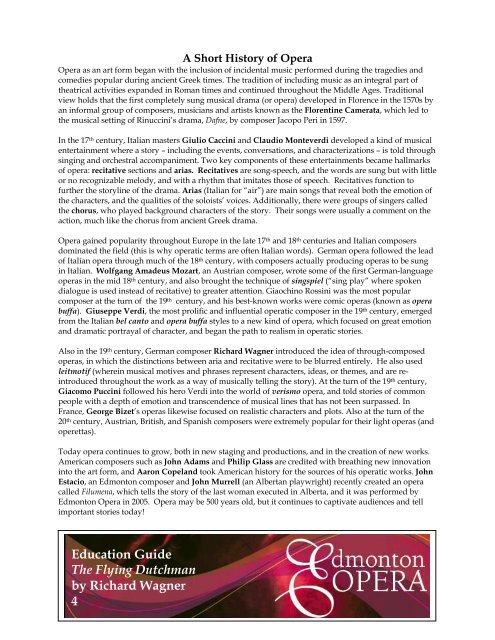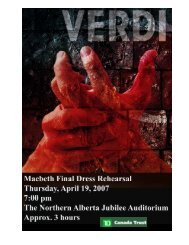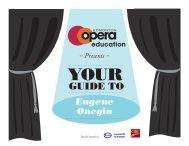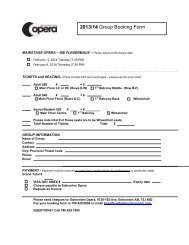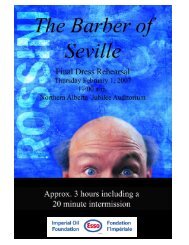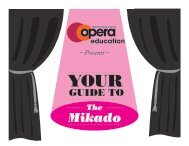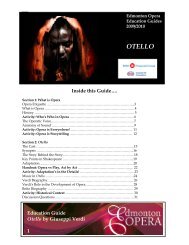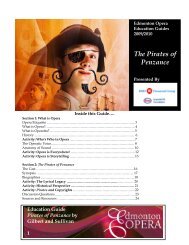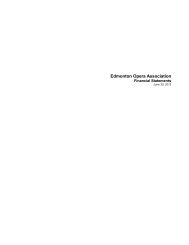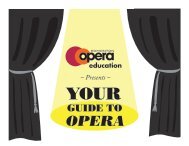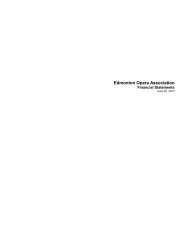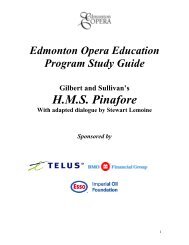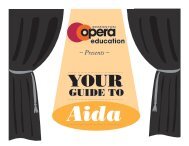Education Guide The Flying Dutchman by ... - Edmonton Opera
Education Guide The Flying Dutchman by ... - Edmonton Opera
Education Guide The Flying Dutchman by ... - Edmonton Opera
You also want an ePaper? Increase the reach of your titles
YUMPU automatically turns print PDFs into web optimized ePapers that Google loves.
A Short History of <strong>Opera</strong><br />
<strong>Opera</strong> as an art form began with the inclusion of incidental music performed during the tragedies and<br />
comedies popular during ancient Greek times. <strong>The</strong> tradition of including music as an integral part of<br />
theatrical activities expanded in Roman times and continued throughout the Middle Ages. Traditional<br />
view holds that the first completely sung musical drama (or opera) developed in Florence in the 1570s <strong>by</strong><br />
an informal group of composers, musicians and artists known as the Florentine Camerata, which led to<br />
the musical setting of Rinuccini’s drama, Dafne, <strong>by</strong> composer Jacopo Peri in 1597.<br />
In the 17 th century, Italian masters Giulio Caccini and Claudio Monteverdi developed a kind of musical<br />
entertainment where a story – including the events, conversations, and characterizations – is told through<br />
singing and orchestral accompaniment. Two key components of these entertainments became hallmarks<br />
of opera: recitative sections and arias. Recitatives are song-speech, and the words are sung but with little<br />
or no recognizable melody, and with a rhythm that imitates those of speech. Recitatives function to<br />
further the storyline of the drama. Arias (Italian for “air”) are main songs that reveal both the emotion of<br />
the characters, and the qualities of the soloists’ voices. Additionally, there were groups of singers called<br />
the chorus, who played background characters of the story. <strong>The</strong>ir songs were usually a comment on the<br />
action, much like the chorus from ancient Greek drama.<br />
<strong>Opera</strong> gained popularity throughout Europe in the late 17 th and 18 th centuries and Italian composers<br />
dominated the field (this is why operatic terms are often Italian words). German opera followed the lead<br />
of Italian opera through much of the 18 th century, with composers actually producing operas to be sung<br />
in Italian. Wolfgang Amadeus Mozart, an Austrian composer, wrote some of the first German-language<br />
operas in the mid 18 th century, and also brought the technique of singspiel (“sing play” where spoken<br />
dialogue is used instead of recitative) to greater attention. Giaochino Rossini was the most popular<br />
composer at the turn of the 19 th century, and his best-known works were comic operas (known as opera<br />
buffa). Giuseppe Verdi, the most prolific and influential operatic composer in the 19 th century, emerged<br />
from the Italian bel canto and opera buffa styles to a new kind of opera, which focused on great emotion<br />
and dramatic portrayal of character, and began the path to realism in operatic stories.<br />
Also in the 19 th century, German composer Richard Wagner introduced the idea of through-composed<br />
operas, in which the distinctions between aria and recitative were to be blurred entirely. He also used<br />
leitmotif (wherein musical motives and phrases represent characters, ideas, or themes, and are reintroduced<br />
throughout the work as a way of musically telling the story). At the turn of the 19 th century,<br />
Giacomo Puccini followed his hero Verdi into the world of verismo opera, and told stories of common<br />
people with a depth of emotion and transcendence of musical lines that has not been surpassed. In<br />
France, George Bizet’s operas likewise focused on realistic characters and plots. Also at the turn of the<br />
20 th century, Austrian, British, and Spanish composers were extremely popular for their light operas (and<br />
operettas).<br />
Today opera continues to grow, both in new staging and productions, and in the creation of new works.<br />
American composers such as John Adams and Philip Glass are credited with breathing new innovation<br />
into the art form, and Aaron Copeland took American history for the sources of his operatic works. John<br />
Estacio, an <strong>Edmonton</strong> composer and John Murrell (an Albertan playwright) recently created an opera<br />
called Filumena, which tells the story of the last woman executed in Alberta, and it was performed <strong>by</strong><br />
<strong>Edmonton</strong> <strong>Opera</strong> in 2005. <strong>Opera</strong> may be 500 years old, but it continues to captivate audiences and tell<br />
important stories today!<br />
<strong>Education</strong> <strong>Guide</strong><br />
<strong>The</strong> <strong>Flying</strong> <strong>Dutchman</strong><br />
<strong>by</strong> Richard Wagner<br />
4


